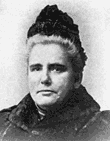
Having been born at New-Castle-on-Tyne, England , February 14, 1847, Anna and her family were very poor. She was one of eight children. In hopes of bettering their condition, the family emigrated to America in 1851. The family settled in New England. Six years later, her father bought a plot of land in Michigan, nine miles north of what is now Big Rapids, then a very small town.
Although Anna was only twelve, she vividly remembered the difficulties her family encountered not only on the journey to Michigan, but also once they arrived. The train only went as far as so the family had to hire a wagon to take their belongings to their new home. The one hundred mile trip took the family a full week, as there were no roads and often no path. Shortly after they arrived at the small one-room cabin in the woods, Anna’s father returned to the east with the two
Former President of the National American Women's Suffrage Association
oldest brothers. The rest of the family had to do the best they could with the supplies they brought. The closest store was ten miles away and was only reached on foot. It’s supplies were minimal.Anna’s schooling was very important to her and she was determined to get a good education, even telling her parents that she wanted to go to college, something women rarely did in those days. A year after their arrival, a school opened three miles from the Shaw’s house and Anna and her brother and sisters walked there every day.
At the age of fifteen, Anna was offered a position as teacher at school five miles from her home, which she accepted. She was offered $2 a week as well as room and board with the school families. She wasn’t paid until the end of the year out of the dog tax fund. Her family was still quite poor and her mother took in boarders from the lumber camp not far from their home.
After the year of teaching, Anna enrolled at the high school in Big Rapids. From the time Anna was young, she had wanted to be a preacher and she soon became well-known in the Big Rapids area. In order to help support her family while her brothers fought in the Civil War, Anna traveled and spoke in many places. Soon she was licensed by the Methodist conference. She entered Albion College in 1873. When she arrived in Albion, she had only $18, hardly enough for room, board and tuition, so soon Anna began preaching there. Again she became well known. Her life was very difficult and she often went hungry when the money ran out.
A chance to go to Boston College came, and she entered the theology school there. Unfortunately throughout her schooling, Anna’s family didn’t approve of her preaching and they gave her no help along the way. Again, she often lacked money for food and other necessities. Soon, Anna finished her course work and was given her first church assignment in East Dennis, Massachusetts. She was very popular and the church members wanted her to stay, but Anna felt she needed to learn more; so in 1885, she enrolled in medical school. She felt that training to be a doctor would help her serve the poor she saw while on her ministry.
Throughout her adulthood, Anna had become more and more aware of the lack of women’s rights. She had been an active member of the Women’s Christian Temperance Union, often speaking against alcohol in her sermons. She was also involved with the suffragette movement, an alliance which brought her the most recognition. She preached in churches, halls and lumber camps, any place people would listed to her.
Anna soon traveled the country, speaking about the vote for women. For ten years she was the president of the National American Women’s Suffrage association. She and Susan B. Anthony were close friends as well as co-workers in the effort to give women the vote and rights as a citizen. Unfortunately, Anna died before seeing the success of her efforts. It wasn‘t until 1920 that the United States added the 19th Amendment to the Constitution, allowing women the right to vote. She died July 2, 1919.
Click here for a text version of this biography.
Photo courtesy of Michigan Historical Center Museum.